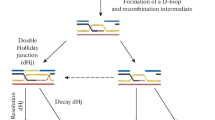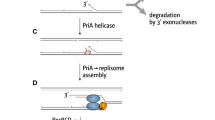Abstract
RecA-like proteins have been purified from somatic and meiotic cells of mouse and lily. The rec proteins have been designated “s-rec” and “m-rec” to indicate their respective tissues of origin. The two proteins differ in molecular weight and in their response to temperature, the latter being consistent with the optimal temperature for physiological function of their tissues of origin. There is a major increase in m-rec protein with the entry of cells into meiosis, the peak of activity being early pachytene. Extracts of the cells and also those of yeast (Saccharomyces cerevisiae) have been prepared that have the capacity to catalyze homologous recombination. These extracts behave similarly to the m-rec proteins upon entry of cells into meiosis. Yeast transferred to sporulation medium displays a 100-fold increase in the recombination activity of the extract at about the time of entry into meiosis. The occurrence of peak levels of m-rec and recombination activity in extracts from cells in early pachytene points strongly to that stage as the time at which the enzymatic phase of recombination occurs.
Similar content being viewed by others
References
Chandley AC, Hotta Y, Stern H (1977) Biochemical analysis of meiosis in the male mouse I. Separation and DNA labelling of specific spermatogenic stages. Chromosoma 62:243–253
Cox MM, Lehman TR (1981) recA protein of Escherichia coli promotes branch migration, a kinetically distinct phase of DNA strand exchange. Proc Natl Acad Sci USA 78:3433–3437
Darby V, Blattner F (1984) Homologous recombination catalyzed by mammalian cell extracts in vitro. Science 226:1213–1215
Dressler D, Potter H (1982) Molecular mechanisms of genetic recombination. Annu Rev Biochem 51:727–761
Emsweller SL, Uhring J (1965) Interaction of temperature and growth regulator in overcoming self-incompatibility in Lilium longiflorum Thunb. Hereditas 52:295–306
Hanahan D (1983) Studies on transformation of Escherichia coli with plasmids. J Mol Biol 166:557–580
Hotta Y, Stern H (1965) Polymerase and kinase activities in relation to RNA synthesis during meiosis. Protoplasma 60:218–232
Hotta Y, Stern H (1974) DNA Scission and repair during pachytene in Lilium. Chromosoma 46:279–296
Hotta Y, Stern H (1978) DNA unwinding protein from meiotic cells of Lilium. Biochemistry 17:1872–1880
Hotta Y, Stern H (1981) Small nuclear RNA molecules that regulate nuclease accessibility in specific chromatin regions of meiotic cells. Cell 27:309–319
Hotta Y, Stern H (1984) The organization of DNA segments undergoing repair synthesis during pachytene. Chromosoma 89:127–137
Hotta Y, Bennett MD, Toldeo LA, Stern H (1979) Regulation of R-protein and endonuclease activities in meiocytes by homologous chromosome pairing. Chromosoma 72:191–201
Hotta Y, Tabata S, Stern H (1984) Replication and nicking of zygotene DNA sequences: Control by a meiosis-specific protein. Chromosoma 90:243–253
Kenne K, Ljungquist S (1984) A DNA-recombinogenic activity in human cells. Nucleic Acids Res 12:3057–3068
Kmiec EB, Holloman WK (1984) Synapsis promoted by Ustilago rec 1 protein. Cell 36:593–598
Kmiec EB, Angelides KJ, Holloman WK (1985) Left-handed DNA and the synaptic pairing reaction promoted by Ustilago rec 1 protein. Cell 40:139–145
Kunz BA, Haynes RH (1981) Phenomenology and genetic control of mitotic recombination in yeast. Annu Rev Genetics 15:57–89
Piñon R (1979) Folded chromosomes in meiotic yeast cells: Analysis of early meiotic events. J Mol Biol 129:433–447
Radding CM (1982) Homologous pairing and strand exchange in genetic recombination. Annu Rev Genet 16:405–437
Setchell BP (1978) The mammalian testis. Cornell Univ Press, Ithaca, NY, p 90–108
Shibata T, Das Gupta C, Cunningham RP, Radding CM (1979) Purified E. coli RecA protein catalyzes homologous pairing of superhelical DNA and single-stranded fragments. Proc Natl Acad Sci USA 76:1638–1642
Stern H, Hotta Y (1983) Meiotic aspects of chromosome organization. Stadler Symposia 15:25–41
Symington LS, Fogarty LM, Kolodner R (1983) Genetic recombination of homologous plasmids catalyzed by cell-free extracts of Saccharomyces cerevisiae. Cell 35:805–813
Symington LS, Morrison PT, Kolodner R (1984) Genetic recombination catalyzed by cell-free extracts of Saccharomyces cerevisiae. Cold Spring Harbor Symp Quant Biol 48:807–814
Von Wettstein D, Rasmussen SW, Holm PB (1984) The synaptonemal complex in genetic segregation. Annu Rev Genet 18:331–413
Author information
Authors and Affiliations
Rights and permissions
About this article
Cite this article
Hotta, Y., Tabata, S., Bouchard, R.A. et al. General recombination mechanisms in extracts of meiotic cells. Chromosoma 93, 140–151 (1985). https://doi.org/10.1007/BF00293161
Received:
Revised:
Issue Date:
DOI: https://doi.org/10.1007/BF00293161




